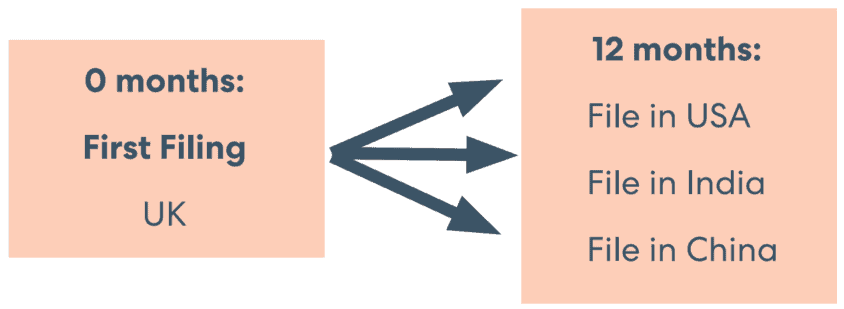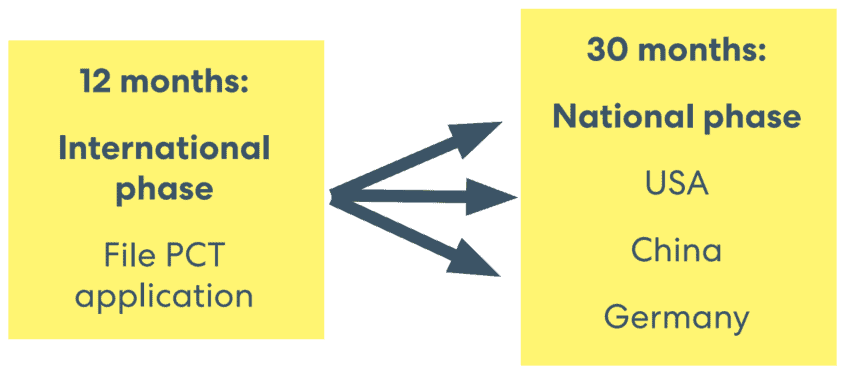There is no international patent to provide global protection for an invention. Instead, a patent must be obtained in each country or region where protection is required as a patent holder is only able prevent another person from using the invention or importing a product that implements the invention in a country or region where a patent is held.
Fortunately, there are several options for applicants that make it easier to obtain patent protection in a number of countries or regions.
Paris Convention
What is the Paris Convention?
The Paris Convention for the Protection of Industrial Property established the right to claim priority. This right means that, after filing a first application in one country, the applicant has 12 months (known as the priority period) to apply for protection in other countries. These subsequent applications will be regarded as if they had been filed on the same day as the first application.
This provision effectively buys applicants more time to file patent applications in multiple countries, so that it is not necessary to file applications in all the desired countries at once.
What are the advantages of using Paris Convention to claim priority?
- Defers decision of where to file for up to a year
- Initial costs are low
Example
An example route to a granted patent is shown in the figure below. A patent application is filed in the UK and the applicant also wants to apply for a patent in the USA, India and China. Within 12 months, they can file national applications in these countries and claim priority based on the earlier UK application. The subsequent applications in the USA, India and China will be considered in many key respects to have been filed on the same date as the UK application.
PCT
What is the PCT?
The Patent Cooperation Treaty (PCT) makes it possible for applicants to seek patent protection for an invention simultaneously in each of a large number of countries. It only requires one application to be filed which, after a certain period of time, can be converted into a number of individual national or regional applications in the contracting states where the applicant requires patent protection. This is known as entering the national or regional phase. The application will then be prosecuted via the patent offices of those nations or regions.
What are the advantages of the PCT?
- The PCT process has a number of advantages when compared with filing individual national applications including:
- Deferred costs until national/regional phase entry (30 months or 31 months, from filing the earliest application)
- Deferred decision making about where to protect an invention until national/regional phase entry
- Only a single application in a single language needs to be filed and monitored prior to national/regional phase entry
It is important to note that although the costs are deferred by taking the PCT route, they can be higher overall. In addition, it typically takes longer for PCT applications to reach grant compared to direct national applications. Therefore, if it is already known where protection is required, and the number of countries is relatively small, direct national applications using the Paris Convention may be the quicker and cheaper option.
Who can apply via the PCT?
When filing a PCT application, at least one applicant must be a resident or national of a country that is a member of the PCT. If this is not the case, it is worth speaking to us to explore what options are available.
Many countries are part of the PCT, but notable non-member countries include Argentina and Taiwan. A full list can be found here.
Example PCT route
Two example routes to a granted patent are shown in the figures below.
In situation (A), the applicant knows they would like to file applications in the UK, the USA, China and Germany. They file a PCT application and after 30/31 months enter the national phase in those countries.
A)
In situation (B), the applicant initially files a patent application in the UK. Within the priority period, the applicant decides they would like to file a number of international applications. They file a PCT application, claiming priority from the UK application. 30/31 months after filing the UK application, the national phase of the PCT application is entered in the US, China, Germany and the UK.
B)
Regional conventions
Regional patents allow applicants to obtain protection in a group of countries. This typically requires a single application to be filed which will be examined in one intellectual property office. This process results in a group of independent, nationally enforceable patents providing the applicant with protection for their invention in some or all of the countries party to the convention. Examples of these include:
- African Regional Intellectual Property Organization (ARIPO)
- Eurasian Patent Organization (EAPO)
- European Patent Office (EPO)
Example route via the EPO
An example route to a granted patent via the EPO is shown below. An applicant files a patent application in the UK. Within 12 months, they file an application at the EPO which claims priority from the initial UK application. When the EPO grants the application, the applicant validates the granted patent application into national patents in their chosen countries: Norway, Switzerland and France.
It is possible to file the initial application directly at the EPO. It is also possible to obtain a European patent via a PCT application, by entering the European regional phase at 31 months from the priority date.
Which method is best for me?
The best route for you will depend on many factors. HLK can work with you to develop an efficient and cost-effective international filing strategy that will help you get the most out of your intellectual property.
Sources of Further Information and Advice
This is for general information only and does not constitute legal advice. Should you require advice on this or any other topic then please contact hlk@hlk-ip.com or your usual HLK advisor.
A PDF of this information can be accessed here.